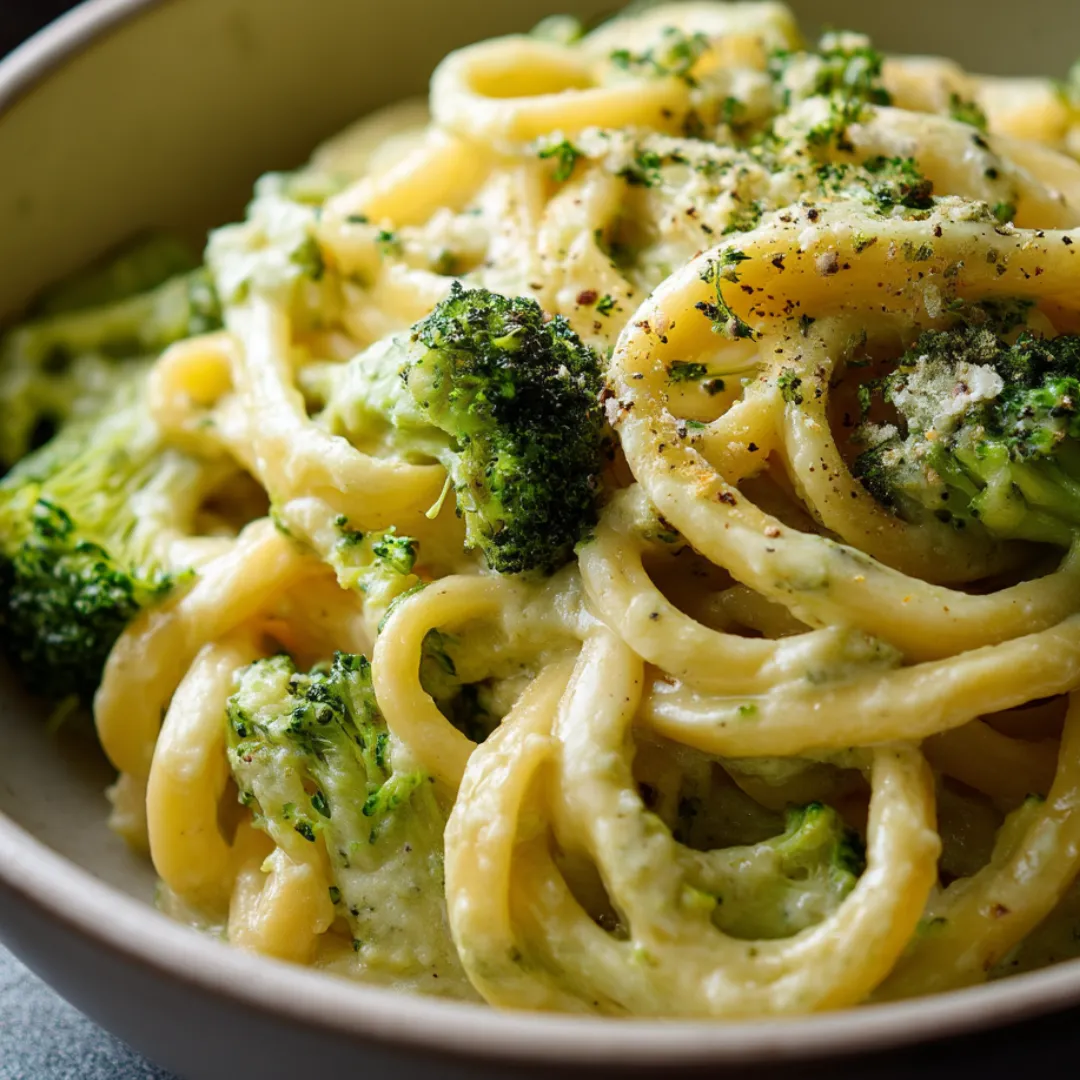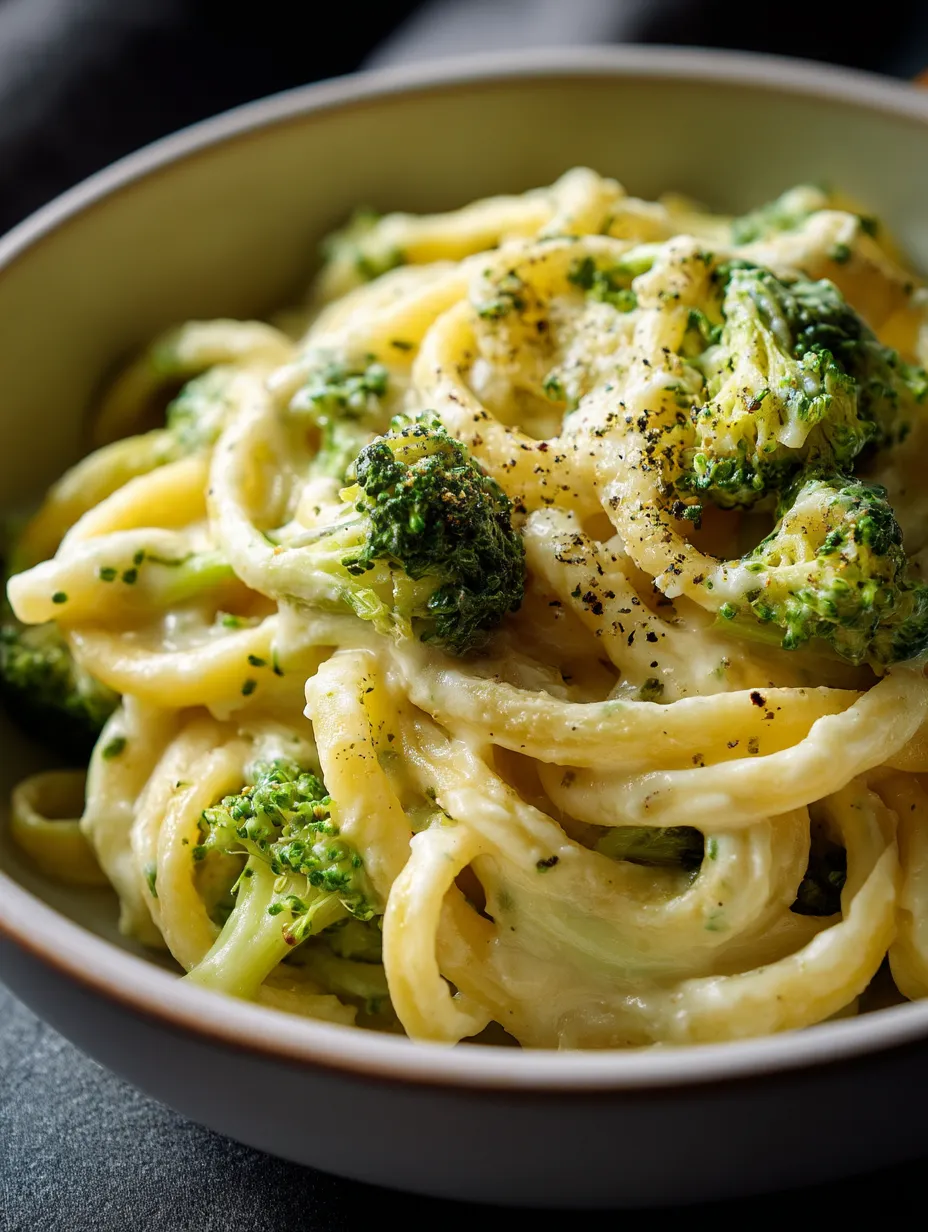 Pin it
Pin it
This velvety pasta dish brings together tender broccoli florets and perfectly cooked pasta, all wrapped in a silky, cheesy sauce that clings to every bite. The contrast between the rich creaminess and the fresh, slightly crisp broccoli creates a satisfying balance that makes this dish incredibly craveable. Surprisingly simple to prepare, this pasta manages to feel both indulgent and wholesome – a rare combination that explains why it has become a standby recipe in so many home kitchens. Whether you're cooking for a weeknight family dinner or looking for something comforting after a long day, this creamy broccoli pasta delivers maximum flavor with minimal effort.
I first made this pasta for my sister when she visited with her picky-eater kids. To my surprise, her 7-year-old, who typically refuses anything green, actually asked for seconds! The creamy sauce worked its magic, making the broccoli not just acceptable but actually delicious to someone who normally pushes vegetables around the plate. Since then, it's become my go-to dish whenever I need something reliable that satisfies both comfort food cravings and the need for something nutritious.
Essential Ingredients
- Broccoli florets: Look for bright green heads with tight, compact florets and no yellowing; cutting them into bite-sized pieces ensures they cook evenly and blend perfectly with the pasta. 4 cups (about 2 medium heads) needed.
- Pasta shapes with texture: Choose shapes that trap sauce in their ridges or curves like penne, fusilli, or orecchiette; their structure holds the creamy sauce much better than smooth shapes. 12 ounces needed.
- Heavy cream: Creates the luxurious base of the sauce; don't substitute with milk or half-and-half if you want that truly silky consistency that makes this dish special. 1 cup needed.
- Freshly grated Parmesan: Avoid pre-shredded varieties which contain anti-caking agents; fresh Parmesan not only melts better but provides that sharp, nutty complexity that elevates the entire dish. ¾ cup needed.
- Minced garlic: Fresh cloves minced just before cooking release aromatic compounds that provide depth to the sauce; pre-minced versions simply can't match the brightness of freshly cut garlic. 3 cloves needed.
 Pin it
Pin it
Step-by-Step Cooking Instructions
- Step 1:
- Properly prepare your pasta water – Fill a large pot with 4 quarts of water, adding 1 tablespoon of salt – it should taste like seawater. This step is crucial as it's your only opportunity to season the pasta itself. Bring to a rolling boil over high heat before adding 12 ounces of pasta. Well-salted water makes the difference between bland and flavorful pasta, regardless of what sauce you're using.
- Step 2:
- Cook pasta to perfect al dente – Add your pasta to the boiling water and stir immediately to prevent sticking. Cook for 1-2 minutes less than the package instructions suggest (about 8-10 minutes for most shapes). This slight undercooking is intentional – the pasta will finish cooking in the sauce, absorbing its flavors while releasing starch that helps thicken the final dish. Test a piece by biting through it – you should see a tiny white dot in the center.
- Step 3:
- Blanch broccoli with precision – While the pasta cooks, bring another pot of salted water to a boil. Add 4 cups broccoli florets and blanch for exactly 2 minutes – they should turn bright green and become slightly tender but maintain a pleasant bite. Immediately drain and plunge into ice water to stop the cooking process. This "shocking" preserves the vibrant color and prevents the broccoli from becoming mushy when it's later incorporated into the hot sauce.
- Step 4:
- Create a flavor foundation – In a large, deep skillet, heat 1 tablespoon olive oil and 1 tablespoon butter over medium heat until the butter is melted but not browned. Add 3 minced garlic cloves and cook for 45-60 seconds, stirring constantly to prevent burning. The garlic should become fragrant and just barely golden – if it starts to brown, lower the heat immediately. This aromatic base will infuse the entire sauce with subtle depth.
- Step 5:
- Develop the silky sauce – Pour 1 cup heavy cream into the skillet with the garlic, stirring to combine. Bring to a gentle simmer – never a full boil, which can cause the cream to break. Allow it to reduce for 3-4 minutes, stirring occasionally, until it coats the back of a spoon. The sauce should be thick enough to cling to pasta but still pourable. Add ¼ teaspoon freshly ground black pepper and a pinch of salt, keeping in mind that the Parmesan will add saltiness later.
- Step 6:
- Enrich with cheese and brighten with lemon – Reduce heat to low and gradually sprinkle in ¾ cup freshly grated Parmesan, stirring constantly to incorporate it smoothly without clumping. Once the cheese has melted completely, add 1 teaspoon fresh lemon juice and stir to combine. This small amount of acid brightens the entire dish without making it taste lemony, balancing the richness of the cream and cheese.
- Step 7:
- Integrate pasta and broccoli – Drain the pasta, reserving 1 cup of the starchy cooking water. Add the pasta directly to the sauce along with the blanched broccoli. Gently toss everything together, using tongs or a wooden spoon, until every piece is coated with sauce. If the sauce seems too thick, add splashes of the reserved pasta water (start with ¼ cup) until you reach your desired consistency. The starch in the water helps the sauce cling to the pasta rather than thinning it out like plain water would.
- Step 8:
- Rest briefly before serving – Allow the pasta to sit in the sauce for 1-2 minutes before serving. This short rest lets the pasta absorb some of the sauce while the flavors meld together. Taste and adjust seasoning with salt and pepper as needed. For serving, transfer to warmed bowls and top with a light sprinkle of additional Parmesan, 2 tablespoons fresh parsley, and a pinch of red pepper flakes if desired.
I learned the importance of pasta water from my Italian neighbor who watched in horror one day as I dumped all my pasta water down the drain. She immediately came over and showed me how just a splash of that starchy liquid could transform a broken or too-thick sauce into silky perfection. My father always claims this broccoli pasta is the only way he enjoys eating "the little trees," as he calls them. Something about the way the creamy sauce clings to both the pasta and broccoli creates a perfect bite every time.
Perfect Pairing Partners
While this creamy broccoli pasta is satisfying on its own, a few simple accompaniments can turn it into a complete meal. A crisp green salad dressed with a bright vinaigrette provides a refreshing contrast to the richness of the pasta. The acidity from the dressing helps cut through the creamy sauce, cleansing your palate between bites.
For wine lovers, a glass of unoaked Chardonnay or Pinot Grigio complements the dish beautifully. The wine's acidity balances the creaminess while its subtle fruit notes enhance the natural sweetness of the broccoli. If you prefer red, opt for something light like a Pinot Noir that won't overwhelm the delicate flavors.
Thoughtful Additions and Variations
The beauty of this creamy broccoli pasta lies in its adaptability. For protein, consider adding 1 cup sautéed chicken pieces, 8 ounces grilled shrimp, or 6 ounces flaked salmon. Each brings its own character to the dish without overwhelming the creamy sauce or tender broccoli.
For a flavor twist, roast the broccoli instead of blanching it. Toss 4 cups florets with 1 tablespoon olive oil, ½ teaspoon salt, and ¼ teaspoon pepper, then roast at 425°F for about 15 minutes until the edges are crispy and slightly charred. This method adds a delicious nutty flavor that works wonderfully with the creamy sauce.
Vegetarians might enjoy adding ¼ cup toasted pine nuts or walnuts for texture and protein. The nuts provide a pleasant crunch against the softness of the pasta and broccoli while contributing healthy fats and a subtle earthy flavor.
 Pin it
Pin it
Making It Ahead Without Compromise
While pasta dishes are typically best enjoyed fresh, busy schedules sometimes require advance preparation. If you need to make this dish ahead, cook both the pasta and broccoli, but keep them separate from the sauce. Refrigerate all components individually.
When ready to serve, gently reheat the sauce in a large skillet, adding a splash of cream (1-2 tablespoons) if needed to restore its silky texture. Warm the pasta and broccoli by briefly dipping them in hot water, then drain and add to the sauce. This method preserves the integrity of each element while still allowing for quick assembly.
I've made this creamy broccoli pasta during nearly every season of my life – as a quick dinner during busy workweeks, as comfort food during difficult times, and as an impressive yet simple dish when hosting friends who appreciate good food without fuss. What I love most about it is how it transforms humble ingredients into something that feels special without requiring advanced cooking skills or hard-to-find components. The way the sauce clings to both the pasta and the bright green broccoli creates a dish that's visually appealing and satisfying in a way that more complicated recipes often aren't. It reminds me that good cooking doesn't always require complexity – sometimes the most beloved dishes are the ones that simply highlight quality ingredients in a thoughtful way.
Frequently Asked Questions
- → Can I use frozen broccoli instead of fresh?
- Yes! Frozen broccoli works well in this recipe. Just thaw it first and skip the blanching step, as frozen broccoli is already blanched. Add it directly to the cream sauce.
- → How can I make this recipe lighter?
- Replace half the heavy cream with reserved pasta water or milk. You can also use half-and-half instead of heavy cream, and reduce the amount of butter and Parmesan.
- → What proteins go well with this pasta?
- Grilled chicken, sautéed shrimp, or crispy bacon all pair beautifully with this creamy broccoli pasta. For a vegetarian protein boost, add white beans or chickpeas.
- → Why is my sauce too thick/thin?
- If too thick, add some reserved pasta water a tablespoon at a time. If too thin, simmer a bit longer or add more Parmesan cheese to help thicken it.
- → Can I make this ahead of time?
- Cream-based pasta dishes are best enjoyed immediately. If needed, prepare the components separately and combine just before serving. When reheating, add a splash of milk or cream to revive the sauce.
